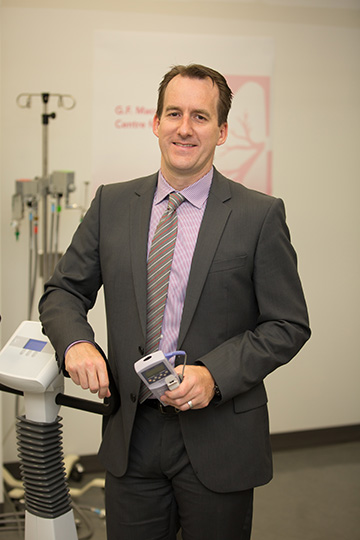
Michael Stickland is using telehealth to provide rural patients with pulmonary rehabilitation for COPD. Photo courtesy of the Department of Medicine.
Pulmonary rehabilitation improves quality of life for patients with chronic obstructive pulmonary disease (COPD). Michael Stickland, a professor in the Department of Medicine and director of the G.F. MacDonald Centre of Lung Health at the Edmonton General Continuing Care Centre, is using telehealth to bring pulmonary rehab to patients across rural Alberta. Stickland is also conducting research to advance the practice and make it even more accessible for all Canadians.
Breathe Easy
In Alberta, COPD is a top reason for hospitalization year after year-it is more common than heart failure and diabetes. COPD patients that complete pulmonary rehab are less likely to have a future episode. Stickland leads Breathe Easy, an Alberta Health Services pulmonary rehabilitation program run through Covenant Health that is delivered in Edmonton and to 10 - 15 communities across Alberta using telehealth.
"The idea is that after the program patients leave in better physical condition, are able to do more and are able to manage their disease," said Stickland.
Pulmonary rehabilitation is a multidisciplinary program typically run by respiratory or physical therapists. Treatment is usually three times a week for six weeks or twice a week for eight weeks. In each session the patients exercise doing strength training and aerobic exercise. The goal is to increase their functional ability and allow them to do things like go up stairs again.
Rehabilitation classes also teach patients to identify triggers, recognize lung flare-ups, modify their medications to respond to triggers and relieve flare-ups, and provide other management skills. The classes also offer other topics of interest to COPD patients, such as how to arrange for air travel with an oxygen tank.
Telehealth: Using technology to reach patients
Telehealth is providing health care remotely using telecommunications technology. Stickland has been working with Covenant Health and Alberta Health Services (AHS) to expand the Breathe Easy program. His goal is to scale it up and spread it across the whole province.
"Telehealth is crucial because Alberta has vast regions with limited access to services or speciality care," said Stickland.
Stickland is also working with the University of Calgary and AHS to develop an evidence-based discharge bundle for COPD
in-patients, which will include a referral to pulmonary rehabilitation.
"The idea is that patients will get connected to rehabilitation post-hospitalization and help the transition from inpatient to outpatient," said Stickland. "Most COPD patients that are hospitalized return to emergency rooms; this could help prevent that."
Since Breathe Easy is one of the largest pulmonary rehab programs in the country, data for research is readily available. About 450 patients are enrolled in the program each year and patient information such as lung function is kept in a database for quality assurance, but that data can also be pulled for research questions.
"We have done a good job integrating research into the program," said Stickland. "A lot of the research is focused on quality improvement so it allows us to do trials on a lower budget than you would expect."
Standardized national program
Stickland has been working with McGill University and the University of Toronto to develop a standardized national pulmonary rehabilitation program. They did an efficacy trial to see if the new program was indeed better than the older program.
There were about 250 patients enrolled in the trial. The data will be analyzed in the coming months and will establish the quality of the new program.
"Many physicians and allied health staff have a lack of knowledge on how to deliver pulmonary rehab. The goal of the new standardized program is to provide all of the information online so it is easily accessible," said Stickland.
Currently, telehealth delivers the program live to remote sites, but if a patient is not available at that time or doesn't have access to video conferencing, they are not able to participate.
The team wants to develop podcasts in French and English so that the new program could be delivered on-demand from a rehab site.